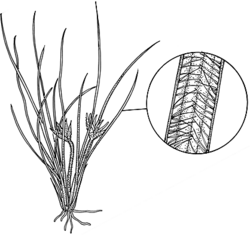Common name: Purple Flag
Patersonia sericea var. longifolia (R.Br.) C.Moore APNI* Synonyms: Patersonia longifolia R.Br. APNI*

Description: Tufted perennial herb to 60 cm high.
Leaves basal, lax, trailing, linear, sword-shaped, 20–50 cm long, 1–2 mm wide, biconvex, glaucous, margins ciliate with a single row of hairs 1–2 mm long inflexed across the leaf, sometimes glabrescent.
Scapes mostly to 15 cm long, pubescent; spathe bracts ovate to lanceolate, 2–3.5 cm long, veined, white-silky to glabrescent, dark brown to blackish, margins 1–2 mm wide, scarious, brown. Perianth tube to 3 cm long; outer tepals broad-ovate, obtuse, 2–3 cm long, to 2.5 cm wide, obtuse, blue-violet; inner tepals ovate, 1–2 mm long. Filaments exserted 4–6 mm, fused to about two-thirds. Ovary pubescent.
Capsule ovoid-cylindrical, 15–25 mm long; seeds cylindrical 2.4–3 mm long, brown with a waxy bloom, ridged, with a large pit; aril absent.
Flowering: October
Distribution and occurrence: Coast and tablelands, south from Nambucca Heads; also in Vic. Grows in dry sclerophyll forest and heath on sandy soil.
NSW subdivisions: NC, CC, SC, CT, ST
Other Australian states: Vic.
A few specimens in the Sydney region are similar to P. longifolia but have terete, glabrous leaves with more acute apex and larger spathes.
Text by T. A. James & E. A. Brown; name updated by H. Sauquet (Apr 2021)
Taxon concept: Flora of NSW 4 (1993)
APNI* Provides a link to the Australian Plant Name Index (hosted by the Australian National Botanic Gardens) for comprehensive bibliographic data
***The AVH map option provides a detailed interactive Australia wide distribution map drawn from collections held by all major Australian herbaria participating in the Australian Virtual Herbarium project.
|


